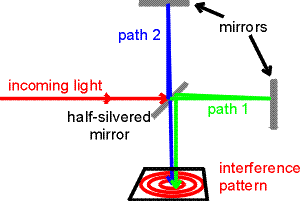
Michelson interferometer
The Michelson interferometer was the crucial instrument for proving the non-existence of the aether. The interferometer produced an interference pattern from light being spit into two separate paths then brought together again as shown below. The light was split in half by using a piece of glass that was coated with silver, but only enough to reflect half the light. When one of the mirrors is moved a half wavelength in distance, the interference pattern shifts by one fringe. If the velocity of light were changed, the wavelength would change proportionally. By rotating the apparatus parallel to Earth's velocity through a supposed ether, the number of wavelengths in each path would change and the interference pattern would shift.

But no such change in the pattern was seen when the apparatus was rotated, which means that if there were an aether it must have zero velocity relative to the interferometer. When Michelson and Morley repeated the experiment 6 months later when Earth's velocity would have changed substantially due to Earth's revolution about the sun, again there was no evidence of a moving ether. The interferometer had to be rotated very gingerly. To accomplish this, the whole apparatus was floated on a pool of mercury.
From our modern point of view, learned from Einstein, the result of the Michelson-Morley experiment is no surprise, because one of the two Postulates of relativity is that absolute uniform motion cannot be detected. The fact of life that makes the experiment insensitive to motion is that when the apparatus is moved (by the motion of the earth), the distance to the mirror in the direction of motion gets shorter by the Lorentz contraction factor 1/g